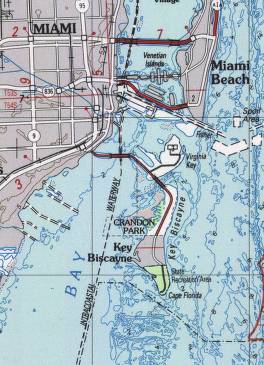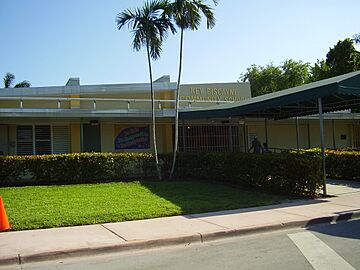Key Biscayne, Florida facts for kids
Quick facts for kids
Key Biscayne, Florida
|
||
|---|---|---|
| Village of Key Biscayne | ||
|
||
| Motto(s):
Island Paradise
|
||
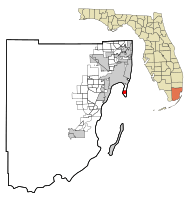
Location in Miami-Dade County and the state of Florida
|
||
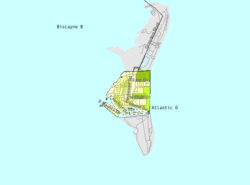
U.S. Census Bureau map showing village boundaries
|
||
| Country | ||
| State | ||
| County | ||
| Incorporated | June 18, 1991 | |
| Government | ||
| • Type | Council-Manager | |
| Area | ||
| • Total | 1.71 sq mi (4.42 km2) | |
| • Land | 1.25 sq mi (3.23 km2) | |
| • Water | 0.46 sq mi (1.19 km2) 8.63% | |
| Elevation | 3 ft (1 m) | |
| Population
(2020)
|
||
| • Total | 14,809 | |
| • Density | 11,875.70/sq mi (4,584.30/km2) | |
| Time zone | UTC−5 (Eastern (EST)) | |
| • Summer (DST) | UTC−4 (EDT) | |
| ZIP Code |
33149
|
|
| Area code(s) | 305, 786, 645 | |
| FIPS code | 12-36300 | |
| GNIS feature ID | 0285075 | |
Key Biscayne is a small island village in Miami-Dade County, Florida, United States. It's part of the larger Miami metropolitan area in South Florida. In 2020, about 14,809 people lived there. This was an increase from 12,344 people in 2010.
Contents
Geography of Key Biscayne
Key Biscayne is located south of Miami Beach and east of Miami. A bridge called the Rickenbacker Causeway, built in 1947, connects the village to Miami. Because Key Biscayne is low and close to the Atlantic Ocean, it's often one of the first places people leave when a hurricane is coming.
The village covers about 1.7 square miles (4.4 square kilometers). Most of this area is land, but about 0.5 square miles (1.3 square kilometers) is water. To the north, you'll find Crandon Park, a county park. To the south is Bill Baggs Cape Florida State Park. The Atlantic Ocean is to the east, and Biscayne Bay is to the west.
History of Key Biscayne
Building the Rickenbacker Causeway

Before 1947, there were ideas to build a town on Key Biscayne. But it was the opening of the 4-mile (6.4 km) long Rickenbacker Causeway that really allowed the island to grow. This causeway connected Miami to Virginia Key and then to Key Biscayne.
For many years, the northern two-thirds of the island was a huge coconut farm. In 1940, the Matheson family gave over 800 acres (3.2 square kilometers) of their land to Dade County. This land became Crandon Park. In return, the county promised to build the causeway to the island.
The rest of the Matheson land was sold to developers. In 1951, the Mackle Construction Company started selling new homes on the island for $9,540, with a small down payment. Soon, a U.S. Post Office opened, a church started, and Key Biscayne Elementary School began in 1952.
The southern part of the island, including Cape Florida, was owned by James Deering and later his brother Charles. In 1948, a Cuban politician named José Manuel Áleman bought the Cape Florida property. After he passed away, his wife bought more land. In 1966, she sold the Cape Florida property to the state of Florida. This land then became Bill Baggs Cape Florida State Park, which opened in 1967.
President Nixon's Visits
In 1969, U.S. President Richard Nixon bought homes on Key Biscayne. This group of homes became known as the Florida White House. He wanted to be close to his friend, Bebe Rebozo, who owned a bank on Key Biscayne. President Nixon visited Key Biscayne more than 50 times between 1969 and 1973.
Becoming a Village
Key Biscayne became its own town, or "municipality," in 1991. It was the first new city in Miami-Dade County in over 50 years. Rafael Conte was elected the first mayor. This change gave the local community more control over their taxes and how the island would grow.
Key Biscayne is known for being a close-knit community. Many families have known each other for a long time. Kids who grow up on the island are sometimes called "Key Rats."
Hurricane Andrew and the Future
In 1992, Hurricane Andrew hit Key Biscayne. It flooded some homes and businesses. The strongest part of the storm passed over Bill Baggs Cape Florida State Park. This storm actually helped the park by destroying plants that weren't native to the area. With government funding, the park was replanted with native plants, making it a beautiful natural spot. Key Biscayne is in an area that often needs to be evacuated during hurricanes.
In 2017, a study showed that parts of the town might be flooded at high tide by 2045 due to sea-level rise. To help protect the island, the town voted in 2020 to approve a $100 million plan.
The village has its own fire department, police department, and public elementary and middle school. It also has a civic center with a recreation center, swimming pool, and a theater program.
Climate and Weather
Key Biscayne has a tropical monsoon climate. This means it has hot, humid summers and warm, dry winters. The island is in USDA plant zone 11a, which is very warm. Because it's an island, Key Biscayne usually has slightly cooler temperatures than Miami throughout the year. Hurricanes can threaten the island, but it's rare for one to hit directly. It also gets less rain than Miami because the ocean can stop summer thunderstorms.
| Climate data for Cape Florida (1991–2020 normals, extremes 1999–present) | |||||||||||||
|---|---|---|---|---|---|---|---|---|---|---|---|---|---|
| Month | Jan | Feb | Mar | Apr | May | Jun | Jul | Aug | Sep | Oct | Nov | Dec | Year |
| Record high °F (°C) | 87 (31) |
87 (31) |
90 (32) |
96 (36) |
93 (34) |
96 (36) |
96 (36) |
96 (36) |
95 (35) |
93 (34) |
90 (32) |
88 (31) |
96 (36) |
| Mean maximum °F (°C) | 83.3 (28.5) |
83.3 (28.5) |
85.9 (29.9) |
88.7 (31.5) |
88.9 (31.6) |
92.0 (33.3) |
92.6 (33.7) |
92.4 (33.6) |
92.1 (33.4) |
90.5 (32.5) |
86.5 (30.3) |
84.3 (29.1) |
93.9 (34.4) |
| Mean daily maximum °F (°C) | 77.5 (25.3) |
78.9 (26.1) |
80.9 (27.2) |
83.8 (28.8) |
86.5 (30.3) |
89.6 (32.0) |
90.8 (32.7) |
91.4 (33.0) |
90.3 (32.4) |
87.2 (30.7) |
82.7 (28.2) |
79.7 (26.5) |
84.9 (29.4) |
| Daily mean °F (°C) | 70.1 (21.2) |
71.8 (22.1) |
74.0 (23.3) |
77.6 (25.3) |
80.7 (27.1) |
83.8 (28.8) |
84.9 (29.4) |
85.4 (29.7) |
84.5 (29.2) |
81.6 (27.6) |
76.7 (24.8) |
72.9 (22.7) |
78.7 (25.9) |
| Mean daily minimum °F (°C) | 62.8 (17.1) |
64.8 (18.2) |
67.1 (19.5) |
71.5 (21.9) |
74.9 (23.8) |
78.0 (25.6) |
79.0 (26.1) |
79.4 (26.3) |
78.7 (25.9) |
76.1 (24.5) |
70.7 (21.5) |
66.0 (18.9) |
72.4 (22.4) |
| Mean minimum °F (°C) | 44.5 (6.9) |
48.1 (8.9) |
52.6 (11.4) |
60.2 (15.7) |
67.0 (19.4) |
71.9 (22.2) |
73.9 (23.3) |
74.4 (23.6) |
74.0 (23.3) |
65.2 (18.4) |
56.3 (13.5) |
50.7 (10.4) |
41.7 (5.4) |
| Record low °F (°C) | 35 (2) |
38 (3) |
44 (7) |
49 (9) |
61 (16) |
64 (18) |
71 (22) |
71 (22) |
66 (19) |
54 (12) |
45 (7) |
37 (3) |
35 (2) |
| Average precipitation inches (mm) | 2.44 (62) |
2.00 (51) |
2.37 (60) |
3.17 (81) |
5.67 (144) |
7.37 (187) |
5.64 (143) |
7.05 (179) |
7.54 (192) |
6.33 (161) |
3.51 (89) |
2.24 (57) |
55.33 (1,406) |
| Average precipitation days (≥ 0.01 in) | 7.9 | 6.5 | 6.3 | 6.1 | 9.9 | 14.8 | 14.9 | 15.8 | 15.3 | 12.8 | 9.0 | 8.0 | 127.3 |
| Source: NOAA (mean maxima/minima 2006–2020) | |||||||||||||
People of Key Biscayne
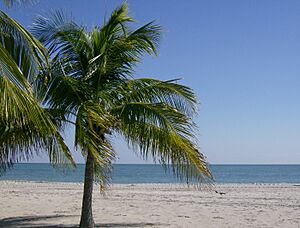
| Historical population | |||
|---|---|---|---|
| Census | Pop. | %± | |
| 2000 | 10,507 | — | |
| 2010 | 12,344 | 17.5% | |
| 2020 | 14,809 | 20.0% | |
| U.S. Decennial Census | |||
Population in 2020
| Race | Number | Percentage |
|---|---|---|
| White (NH) | 3,979 | 26.87% |
| Black or African American (NH) | 27 | 0.18% |
| Native American or Alaska Native (NH) | 3 | 0.02% |
| Asian (NH) | 106 | 0.72% |
| Pacific Islander or Native Hawaiian (NH) | 0 | 0.00% |
| Some other race (NH) | 87 | 0.59% |
| Two or more races/Multiracial (NH) | 719 | 4.86% |
| Hispanic or Latino (any race) | 9,888 | 66.77% |
| Total | 14,809 |
In 2020, there were 14,809 people living in Key Biscayne. There were 4,058 households and 3,174 families.
Population in 2010
| Key Biscayne Demographics | |||
|---|---|---|---|
| 2010 census | Key Biscayne | Miami-Dade County | Florida |
| Total population | 12,344 | 2,496,435 | 18,801,310 |
| Population, percent change, 2000 to 2010 | +17.5% | +10.8% | +17.6% |
| Population density | 10,070.7/sq mi | 1,315.5/sq mi | 350.6/sq mi |
| White or Caucasian (including White Hispanic) | 96.2% | 73.8% | 75.0% |
| (Non-Hispanic White or Caucasian) | 36.5% | 15.4% | 57.9% |
| Black or African-American | 0.4% | 18.9% | 16.0% |
| Hispanic or Latino (of any race) | 61.6% | 65.0% | 22.5% |
| Asian | 1.1% | 1.5% | 2.4% |
| Native American or Native Alaskan | 0.1% | 0.2% | 0.4% |
| Pacific Islander or Native Hawaiian | 0.0% | 0.0% | 0.1% |
| Two or more races (Multiracial) | 1.2% | 2.4% | 2.5% |
| Some Other Race | 1.0% | 3.2% | 3.6% |
In 2010, there were 12,344 people living in Key Biscayne. There were 4,256 households and 2,976 families.
Local Media
The Islander News is a weekly newspaper that serves Key Biscayne. In 2020, about 3,600 copies were printed.
Key Biscayne Magazine is a magazine about the lifestyle on the island. It's published by TAG Media, which also publishes Brickell Magazine. In 2020, about 10,000 copies of the magazine were circulated.
Education in Key Biscayne
The Miami-Dade County Public Schools system serves Key Biscayne. The Key Biscayne K–8 Center is the local school for students from kindergarten to eighth grade. Middle school students can also choose to go to Ponce de Leon Middle School in Coral Gables. For high school, students attend Coral Gables Senior High School.
MAST Academy, a special magnet school on Virginia Key, gives priority to eligible Key Biscayne residents. This started in 2012 for 1,100 spots in the school's Cambridge program.
The Miami-Dade Public Library System has a 6,000 square foot (557 square meter) branch in Key Biscayne. It opened in January 1985.
St. Agnes Academy is a private Catholic school located at 122 Harbor Drive. It's part of the Roman Catholic Archdiocese of Miami and serves students from pre-kindergarten to 8th grade.
Notable People from Key Biscayne
Many interesting people have lived in Key Biscayne, including:
- Jaime Bayly, a writer
- Jay Berger, a former tennis player
- Raul Boesel, a race car driver
- Cher, a famous actress and singer
- Soman Chainani, a writer
- Emerson Fittipaldi, a race car driver
- Andy García, an actor
- Juanes, a Colombian singer
- Juan Pablo Montoya, a Colombian race car driver
- Richard Nixon, a former U.S. president
- Brad Pitt, an actor
- Eddie Rickenbacker, a famous fighter pilot for whom the causeway is named
Things to Do in Key Biscayne
Key Biscayne is home to the Tennis Center at Crandon Park. This center used to host the Miami Open Tennis Tournament. The island also has a golf course and many places for water sports and fishing.
If you visit, there's a visitors center in the Village Hall at 88 West McIntyre Street #100, right next to the police station. It's open all day, every day, all year round. Staff are there Monday to Friday from 9 AM to 5 PM.
Gallery
See also
 In Spanish: Key Biscayne (Florida) para niños
In Spanish: Key Biscayne (Florida) para niños



